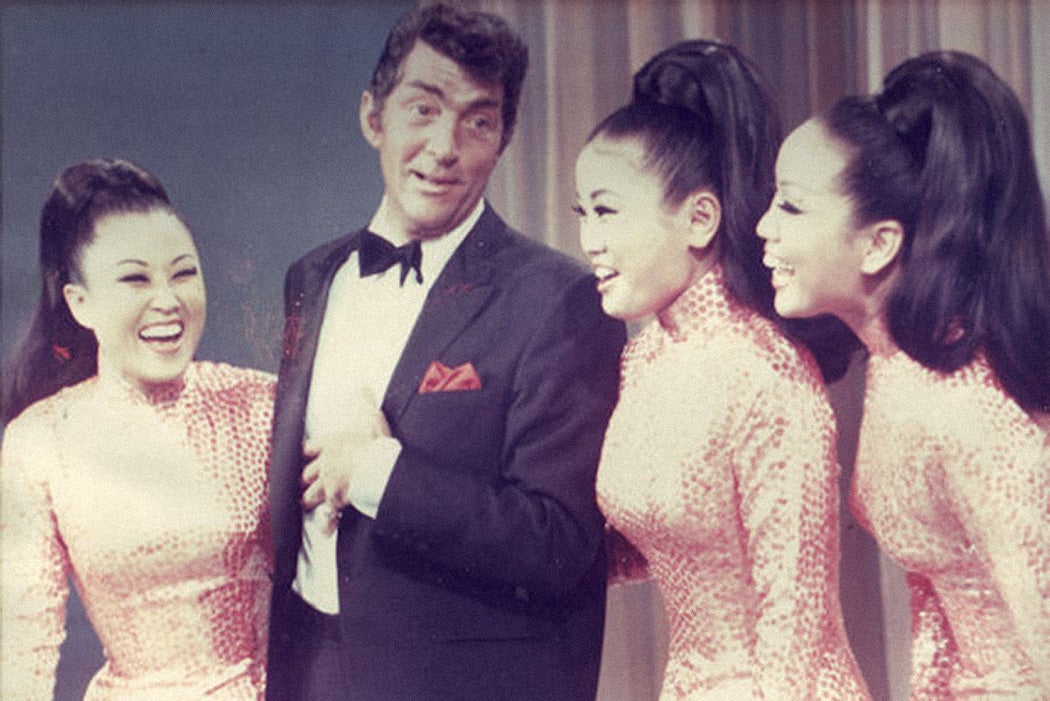Long before K-pop, the Korean-born Kim Sisters made a splash in the US, debuting as teenagers in Las Vegas in 1959. They moved on to a top-ten single with a cover of Leiber and Stoller’s “Charlie Brown” and were popular guests on television variety programs like The Ed Sullivan Show. Media historian Benjamin M. Han argues that, on TV, they became “embodiments of US internationalism”—three plucky, talented girls who survived communism and supposedly triumphed, like South Korea itself, “with the aid of American militarism.”
Han situates the Kims as an example of the “ethnic spectacle” of American variety show television, a piece of the “false projection of US race relations” in the Cold War. While the US was being hammered in international politics because of its version of apartheid, viewers abroad and at home could watch a television fantasy of America, where whites and Blacks, Americans and Asians, et cetera, performed one after the other. At the same time, Han stresses, the Kims had to navigate “the complex structures of American Orientalism ascribed to them by television as both racialized and sexualized Asian female subjects.”
Kim Sook-ja, Kim Min-ja, and Kim Ai-ja were known in the US as Sue, Mia, and Aija (a.k.a. Aecha) Kim. Mia was a cousin adopted into the family after Sue’s and Aija’s father, a well-known composer and conductor, was kidnapped and killed by North Koreans. Their mother, Nanyŏng Yi, was a popular singer before the Korean War, performing for American soldiers with her daughters. In 1954, the three girls, then ranging in age from eleven to thirteen, became an act on their own.
The Kims learned American songs from GIs. The massive US military presence in South Korea and Japan helped develop what Han calls the “feminization of the image of Asia” in the American mind. Aspects of this included lots of prostitution around military bases, and young, highly sexualized “all-girl” Asian bands like the Kim Sisters, the Korean Kittens, and the Tokyo Happy Coats.
In 1950s America, meanwhile, Asian nightclub acts were having their heyday. Traveling performers like the “Geisha Revue” played the coasts and in-between venues like Las Vegas. Agents scouted Asia for young female talent, vetted by US military popularity, even though a fair number of supposedly exotic Asian acts in the US were American-born performers pretending to be foreigners.
The “China Doll Revue” was mostly made up of Asian-born performers, or, as the advertising pitched it: “20 of the most beautiful oriental showgirls ever assembled on stage; direct from so. Korea, Honolulu, Hong Kong, and Macau.” The Kims made their American debut with the China Doll Revue at the Thunderbird Hotel in Las Vegas in 1959. (Initially, the South Korean government, worried the sisters wouldn’t be good for Korea’s image, was reluctant to let them travel, but the Korean Ambassador to the US persuasively argued they would be great cultural ambassadors.)
Weekly Newsletter
Ed Sullivan had them on his show for the first of twenty-two times in September 1959. Sullivan was known for featuring both international talent and African American talent when most of narrative television was almost completely white. His show won a Peabody Award for furthering international understanding in 1960. Han argues that Sullivan “played an instrumental role in disseminating a racially integrated image of the United States, where different races and culture intermingled harmoniously via musical performances.” However, there were lines Sullivan would not cross: in 1959, he nixed a Chinese-European duo, because, as he wrote to the agent, “the American public would take offense with a Chinese man working with a white woman.”
Assimilationist media narratives about the bobby-sox-wearing Kims—who mostly performed covers of American standards—mixed with the sisters’ own insistence on being introduced as from the Republic of Korea. Han quotes Sue Kim Bonifazio in a 2009 interview still marveling that Americans couldn’t tell the difference between North and South Korea, much less between people from Korea, China, or Japan.
The sisters made their last television appearance together in 1970 on The Merv Griffin Show. They took American citizenship and continued to perform live, sometimes with their brothers (a.k.a. the Kim Brothers), until they went their separate ways.







